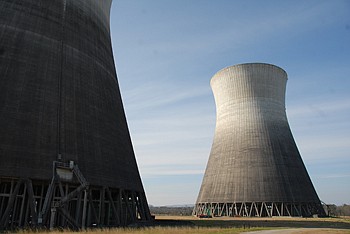TANNER, Ala. - The remnants of the Cold War could heat up nuclear plants for the Tennessee Valley Authority in the next decade.
In a modern-day example of the biblical call to beat swords into ploughshares, U.S. Department of Energy officials outlined plans Tuesday to reprocess plutonium from abandoned nuclear warheads into mixed-oxide fuel to power TVA's biggest nuclear power plants by 2018.
The DOE proposal could help the military dispose of 34 metric tons of surplus weapons material while giving TVA cheaper fuel for its Sequoyah reactors near Soddy-Daisy and its Browns Ferry reactors near Athens, Ala.
But during the first of five planned hearings on the idea here Tuesday night, critics of the concept warned that it unduly will mix civilian and military use of nuclear technologies and increase the risk of an accident at TVA's reactors.
Ed Lyman, senior staff scientist with the Union of Concerned Scientists, said the mixed-oxide fuel "increases both the risks of an accident and the consequences of an accident" should there be an equipment or personnel failure at Sequoyah or Browns Ferry.
TVA already uses reprocessed surplus uranium from DOE for a type of blended, enriched uranium fuel burned at Browns Ferry. It also irradiates tritium in its reactor at Watts Bar Nuclear Plant to produce weapons-grade materials for bombs. But Lyman said using the mixed-oxide fuel enhances further the risk of a terrorist attack.
T.A. Keys, manager of nuclear fuels for TVA, said the MOX fuel should be a cheaper fuel source for TVA and help the military dispose of the surplus plutonium.
"We have not made any decision, but whatever TVA does it will be done to help reduce our costs and to help meet these national goals," he said.
TVA signed an agreement last year to work with DOE on testing mixed-oxide fuel after Duke Energy abandoned similar tests after two fueling cycles at its Catawba Nuclear Plant in South Carolina. Duke officials said they gave up on the idea because of concerns about the reliability of supply, not the fuel itself.
Keys said the utility should be able to begin limited use of mixed-oxide fuel by 2018 given TVA's success in burning blended uranium from the weapons program at Browns Ferry and earlier fuel assembly tests at Duke's Catawba nuclear plant.
But Lyman called the initial fuel assembly tests at Catawba "a failure."
"MOX fuel is too dirty, dangerous and expensive," Lyman said.
Sandra Kurtz, a Chattanooga environmentalist and member of the Bellefonte Efficiency and Sustainability Team, plans to raise objections to the mixed-oxide fuel plan during another public hearing Thursday night in the Chattanooga Convention Center.
"It's hard to understand why TVA thinks plutonium and MOX fuel processing is a worthwhile project when Duke Power has decided not to do it based on plant safety analysis," she said. "It's an unnecessary risk citizens shouldn't have to bear."
But in his announcement of the agreement with TVA to possibly test mixed-oxide fuel usage, Ken Baker, the deputy administrator at the Department of Energy's National Nuclear Security Administration, said the planned reactor tests at Sequoyah and Browns Ferry are "an important step" in evaluating the use of MOX fuel "in a way that realizes the energy value of the material and advances our nuclear nonproliferation agenda."
As a federally owned corporation, TVA's charter calls for the utility to serve a multitude of purposes, including national defense. TVA spokesman Terry Johnson said the agency is working with DOE to help the military recapture some of the energy potential of plutonium from disassembled bombs while giving TVA a potentially less-expensive source of nuclear fuel for the long run.
TVA has made no decision on using the mixed-oxide fuel, however. The Nuclear Regulatory Commission would have to approve a license amendment for TVA to burn such fuel.
Tom Clements, the Southeastern Nuclear Campaign Coordinator for Friends of the Earth, said documents his group obtained from TVA indicate that mixed-oxide fuel could be part of a bigger effort by TVA to help promote more reprocessing of nuclear fuel in East Tennessee.
With Yucca Mountain in Nevada no longer being pushed by the Obama administration for storage of spent nuclear fuel, Clements said East Tennessee "could become a dumping ground" for radioactive materials from old nuclear weapons material and spent nuclear fuel.
"There are some real risks that I would hope the people of the Tennessee Valley are cautious about undertaking with these moves," he said.
Continue reading by following these links to related stories:
Article: Sequoyah to produce bomb-grade material
